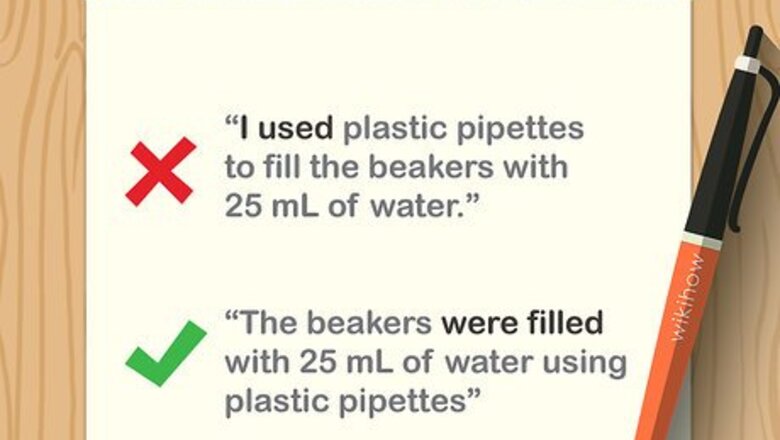
views
X
Research source
Using Clear Scientific Writing

Write the lab report in the passive voice. Science writing focuses on presenting data and results and should use clear language with no ambiguity. Lab reports should describe the experiments and methods in an objective manner which any other researchers could follow exactly. Using the passive voice lets science writers highlight the mechanics and data results of an experiment. So, instead of writing, “I used plastic pipettes to fill the beakers with 25 mL of water,” write “The beakers were filled with 25 mL of water using plastic pipettes.” Use as few pronouns as possible when writing your lab report. Pronouns to avoid using include “I,” “we,” and “they.”
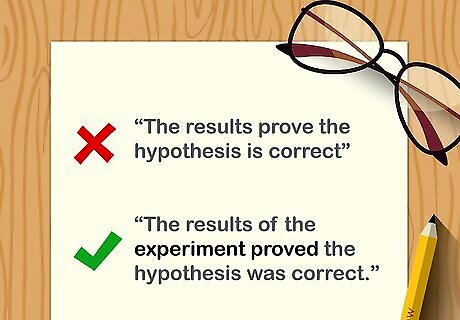
Compose the majority of the lab report using the past tense. Most sections of the lab report should be written in the past tense since it describes scientific work that has already been completed. The Methods and Results sections especially should be written in the past tense. For instance, instead of saying, "The results prove the hypothesis is correct," say, "The results of the experiment proved the hypothesis was correct." The Introduction is one of the few parts of the lab report which can be written in the present tense.

Review the lab-report rubric before you start writing. Each instructor at your institution may have a different set of standards for grading, so it’s essential to understand how you will be evaluated on your report. Check through the rubric to find out the exact specifications that your instructor has requested regarding length, formatting, margins, font type and size, and writing style. For example, an instructor may: Add/subtract/merge certain structural elements of a report. Grade one part of a report more heavily than another. Require reports to be typed, using a specific font and size. Require reports to be handwritten in a research notebook.
Composing the Introduction and Purpose Statement
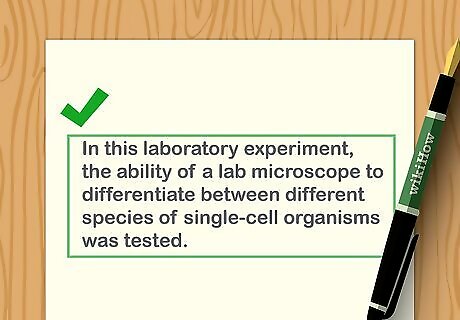
Write an Introduction only if your instructor requests one. Most microbiology lab reports do not have an Introduction and begin with the Purpose section. However, if your instructor does request an Introduction, it should not exceed 4-6 sentences. Concisely explain the nature of your experiment, the findings you reached, and why the experiment was important. For example, your Introduction could begin, “In this laboratory experiment, the ability of a lab microscope to differentiate between different species of single-cell organisms was tested.” Methods and Results should all be written in the past tense, since you’ll be summarizing actions that you’ve already performed as part of the lab.
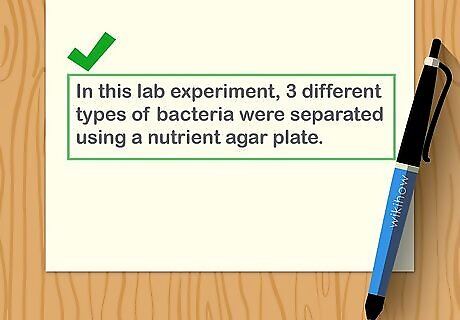
Include your purpose and hypothesis in the Purpose section. An effective Purpose Statement should clearly explain the main objective of the experiment. Depending on the specific lab, the purpose may be to practice or learn a new technique or test, or to evaluate a characteristic of a microorganism. In the Purpose section you should also include background information about the experiment, including the reason that you’re performing the experiment. This information can be found in the lab manual or related microbiology textbook. For example, begin your Purpose statement by writing something like, “In this lab experiment, 3 different types of bacteria were separated using a nutrient agar plate.”
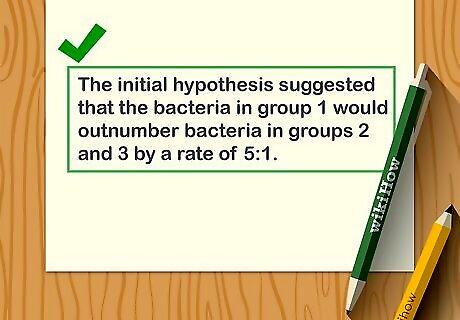
State your hypothesis at the end of the Purpose section. A hypothesis is an educated guess about the outcome that you expect to reach by conducting the experiment. Use the last 1 or 2 sentences of your Purpose section to state the outcome that you expected before beginning the experiment. For example, write: “The initial hypothesis suggested that the bacteria in group 1 would outnumber bacteria in groups 2 and 3 by a rate of 5:1.” Finally, the Purpose section should state, but not extrapolate on, all techniques or tests used in the experiment. Keep things cursory here, though, since you’ll give detailed information about the techniques and methods used in the Methods section.
Writing the Methods and Results Sections
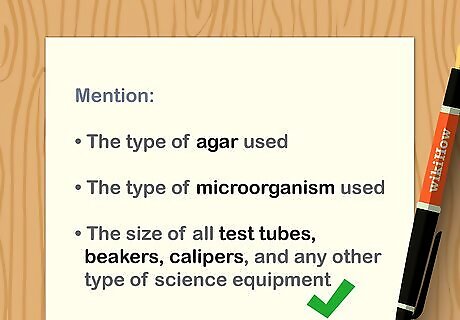
State the materials you used in the experiment in the Methods section. This information should open the Methods section. The majority of this information will be provided by your lab manual or given by your instructor. Don’t use bullet points. Write out full sentences which clearly state the materials necessary to perform the experiment. If you used an unknown microorganism in the experiment, record the number, letter, or identifying characteristic of the microorganism. Also state: The type of agar (if agar was used). The type of microorganism used (if the organism types were known beforehand). The size of all test tubes, beakers, calipers, and any other type of science equipment. For example, the materials description could include a sentence like: “Five 50-mL beakers were used to contain the water and single-celled organisms. The water was applied to microscope slides using 1-mL plastic pipettes.”
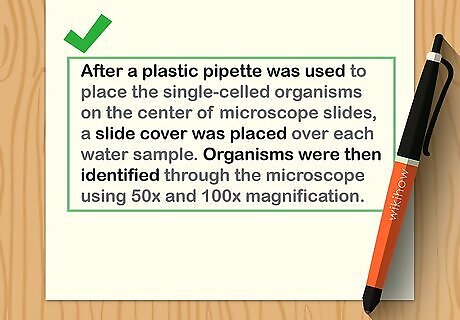
Describe the steps performed during the experiment in the Methods section. This is the core of the Methods section. The Methods section should be written in enough detail that another researcher could replicate the experiment using your Methods as a guide. So, if the procedure for the experiment is found in your lab manual, summarize the steps in this section. Your instructor may require you to do this in a paragraph or a list form. If your instructor deviated from the original experiment, make adjustments as needed. For example, write something like, “After a plastic pipette was used to place the single-celled organisms on the center of microscope slides, a slide cover was placed over each water sample. Organisms were then identified through the microscope using 50x and 100x magnification.”
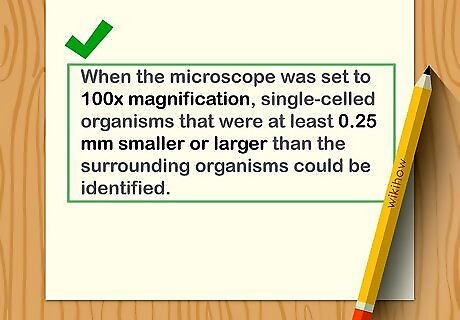
Record your results using specific data measurements in the Results section. The Results section needs to be detailed and should explicitly refer back to your hypothesis and explain whether the experiment confirmed or disproved the hypothesis. This is also the section in which you should include all data acquired from the experiment. These data should be presented in standard metric units: mm, cm, m, g, mg, etc. However, do not interpret the scientific data in the Results section. Only interpret data in the Discussion section. For example, write something like, “When the microscope was set to 100x magnification, single-celled organisms that were at least 0.25 mm smaller or larger than the surrounding organisms could be identified.”

Focus the Results on trends and phenomena you were asked to test. Keep your Results focused on the central question of the lab experiment, and write down the relevant differences and unique characteristics that you noticed while performing the experiment. Be as specific as possible, and do not describe scientific phenomena unrelated to microbiological science. For example, if a bacteria that you were asked to observe had consistent physical traits, describe these in the Results section. Write something like, “The reactions of single-celled organisms to different water temperatures and chemical additives were noted. It was noted that, as less-diluted chemicals were added, the organisms acted in increasingly unpredictable ways.”

Include figures and tables in the Results section if your instructor requested them. Not all lab reports need to have figures and tables. However, these can be effective ways to present large amounts of data in a condensed amount of space. Tables and figures should be numbered sequentially and should have clearly labeled x- and y-axes. Figures and tables should also be mentioned and explained in the main text of your Results section.
Putting Together the Discussion and References Sections

Interpret and contextualize your data findings in the Discussion section. Explain your results and observations in detail in this section. Narrate how all of the data you generated fit together, and explain how you arrived at your specific interpretation of the data. If the data can be interpreted in more than a single way, account for the other way(s) in which data can be interpreted. Explain why you chose 1 interpretation over another. Also state if you have fulfilled the purpose of the experiment. The Discussion section is usually the most important section of the lab report. It shows that you’ve understood the experiment you just performed and are able to engage with the scientific implications. For example, write, “The amoebas were observed displaying consistent behavior throughout the observation period. The data suggests that the organisms were unable to detect the variety of chemicals that were added to different water samples, which the amoebas were then suspended in.”
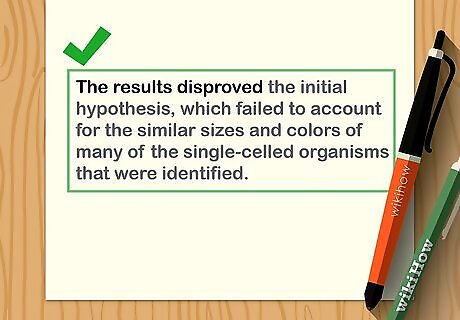
Explain whether the results supported or disproved your hypothesis in the Discussion section. Remember that you don’t need to feel like you failed the lab if the results didn’t support your hypothesis. Scientific hypotheses are routinely disproven by experiments at every level of science. But, engage critically and objectively with your findings even if the results weren’t what you expected. You could state something as simple as, “The results disproved the initial hypothesis, which failed to account for the similar sizes and colors of many of the single-celled organisms that were identified.” If your results do not support your hypothesis, ask questions like, was there any error during the experiment? Did you miss a step in the experiment? Did you use proper techniques? Were your results accurate?

Reference all sourced material in a References or Bibliography section. Include references to any and all documents or texts that you used to construct your report; this may need to include the lab manual. In a bibliography, you’ll need to include full, correct citations for any academic scholarship, literature reviews, or studies that you consulted when making your lab report. The bibliography should be the last section in your lab report. If you should include a References section instead of a Bibliography, you’ll only need to include citation information for sources that were cited in the lab report. Ask your instructor which citation style you should use when compiling your Bibliography. For example, most microbiology TAs will ask you to use Chicago style. Most lab reports have short Bibliographies, since very few lab reports cite more than 1 or 2 sources (if any).


















Comments
0 comment